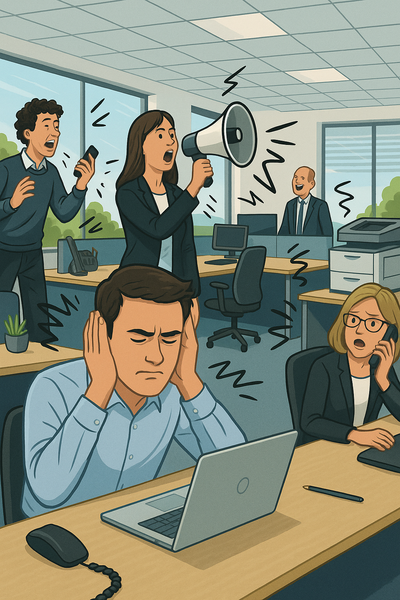New Zealand workplaces are getting louder. Open-plan offices, collaborative hubs, and hybrid workspaces may look modern, but the unintended side effect is constant background chatter.
And the science is clear: noise costs us focus, health, and money.
The Hidden Drain on Productivity
International studies show that background conversations reduce working-memory performance by 6–7 percent (Jahncke & Halin, Noise & Health, 2012). It’s not that workers choose to listen—it’s that the human brain can’t help processing speech.
Even at moderate levels, noise raises stress hormones, according to a landmark Science study (Evans & Johnson, 2000). Workers in noisy spaces reported less motivation, higher tension, and faster fatigue.
Put simply: a noisy office makes people slower, more tired, and more stressed.
Standards Catching Up
Global benchmarks now define what a “healthy” office should sound like. ISO 3382-3 calls for a distraction distance under 5 metres and speech levels below 48 dB(A). The WELL Building Standard recommends maximum background noise levels and sound masking in open spaces.
Closer to home, the Health and Safety at Work Act 2015 requires Kiwi employers to provide work environments free from risks to health—including psychological stressors like noise. WorkSafe NZ already lists noise as a workplace hazard.
The Fix: Absorb, Block, Mask
That’s where acoustic design comes in. Instead of rebuilding offices, workplaces can retrofit smart solutions: partitions, sound-absorbing wall panels, ceiling baffles, and masking systems.
Versare NZ offers one practical example. Their SoundSorb acoustic panels carry an NRC rating of 0.6—absorbing about 60% of sound energy in the speech range. Installations covering just 25% of wall space can significantly reduce echo and chatter, bringing offices closer to international acoustic standards.
Unlike permanent renovations, these solutions are modular, portable, and budget-friendly—ideal for schools, healthcare providers, or offices wanting results without major disruption.
From Perk to Right
Noise control is no longer a “nice-to-have” feature. Just as employers now invest in ergonomic chairs and clean air, they must take acoustics seriously.
A calmer workplace means sharper thinking, healthier staff, and better business outcomes. The real question isn’t whether we can afford to improve workplace acoustics—it’s whether we can afford not to.
Breakout Box: What NRC 0.6 Means
- NRC (Noise Reduction Coefficient) is the measure of how much sound a material absorbs.
- 0.6 NRC = absorbs 60% of sound energy in the frequencies of human speech.
- The higher the NRC, the less sound bounces back into the room.
- For most offices, covering 20–25% of surfaces with NRC 0.6 materials delivers noticeable improvements in speech clarity and focus.
Key Sources
- Jahncke, H., & Halin, N. (2012). Noise & Health, 14(60), 229–239.
- Evans, G. W., & Johnson, D. (2000). Science, 291(5505), 191–193.
- ISO 3382-3:2012. Acoustics – Measurement of room acoustic parameters – Part 3: Open plan offices.
- WELL Building Standard v2 (International WELL Building Institute, 2020).
- Health and Safety at Work Act 2015 (NZ).
- WorkSafe NZ. Noise – Managing the health risks.
 New Zealand Dollar
New Zealand Dollar

